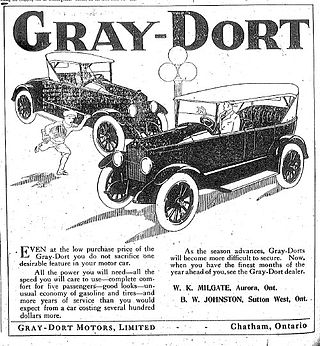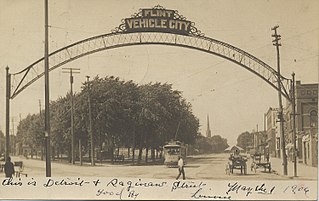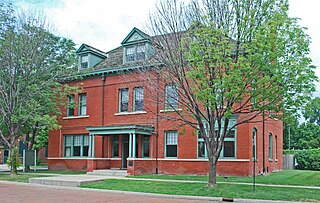Buick is a division of the American automobile manufacturer General Motors (GM). Started by automotive pioneer David Dunbar Buick in 1899, it was among the first American marques of automobiles, and was the company that established General Motors in 1908. Before the establishment of General Motors, GM founder William C. Durant had served as Buick's general manager and major investor. With the demise of Oldsmobile in 2004, Buick became the oldest surviving American carmaker.

McLaughlin Motor Car Company Limited was a Canadian manufacturer of automobiles headquartered in Oshawa, Ontario. Founded by Robert McLaughlin, it once was the largest carriage manufacturing factory in the British Empire.

Charles Williams Nash was an American automobile entrepreneur who served as an executive in the automotive industry. He played a major role in building up General Motors as its 5th President. In 1916, he bought Thomas B. Jeffery Company, makers of the popular Rambler automobile, renamed it Nash Motors, and played an independent role in an automobile industry increasingly dominated by the Big Three: General Motors, Ford, and Chrysler. His profits came from focusing on one well-designed car in the upper-medium price range. He bought several distressed companies in Wisconsin, merging them and installing advanced managerial accounting procedures while cutting costs and focusing on long-term growth. He retired as president in 1932, but remained chairman of the board. His major acquisition was the merger in 1937 with the Kelvinator Company, which made refrigerators. During World War II, Nash-Kelvinator greatly expanded to manufacture aircraft engines and parts.

Louis-Joseph Chevrolet was a Swiss-American race car driver, mechanic and entrepreneur who co-founded the Chevrolet Motor Car Company in 1911.

William Crapo Durant was a leading pioneer of the United States automobile industry and co-founder of General Motors and Chevrolet. He created a system in which a company held multiple marques – each seemingly independent, with different automobile lines – bound under a unified corporate holding company. Durant, along with Frederic L. Smith, co-founded General Motors, as well as Chevrolet with Louis Chevrolet. He also founded Frigidaire.

Durant Motors Inc. was established in 1921 by former General Motors CEO William "Billy" Durant following his termination by the GM board of directors and the New York bankers who financed GM.

The Dort Motor Car Company of Flint, Michigan, built automobiles from 1915 to 1924.

Mason Motors, founded by A. C. Mason in cooperation with William C. Durant, was a U.S. truck manufacturer based in Flint, Michigan. As a subsidiary of Durant Motors, Mason Truck built Road King Speed Trucks in the early 1920s. Mason Motors also built automobile engines in 1911, who first led Buick's engine works in Flint. That company was absorbed by Chevrolet in 1915, but remained under the Chevrolet umbrella until January 1, 1918, when it became known as the Motor and Axle Division of Chevrolet.

Gray-Dort Motors was a Canadian automobile manufacturer in Chatham, Ontario, Canada, from 1915 to 1925. It started as Canadian carriage works of William Gray & Sons Company Ltd, founded in 1855 by William Gray. In the mid 1900s Robert Gray began to build Ford bodies for the Walkerville factory. They continued to do so until 1912.

Flint, Michigan is a city which previously relied on its automotive industry, and still does to an extent. Over the past several decades, General Motors plants in Genesee County have experienced re-namings, management shifts, openings, closures, reopenings, and spinoffs.

The history of General Motors (GM), one of the world's largest car and truck manufacturers, dates back more than a century and involves a vast scope of industrial activity around the world, mostly focused on motorized transportation and the engineering and manufacturing that make it possible. Founded in 1908 as a holding company in Flint, Michigan, as of 2012 it employed approximately 209,000 people around the world. With global headquarters at the Renaissance Center in Detroit, Michigan, United States, General Motors manufactures cars and trucks in 35 countries. In 2008, 8.35 million GM cars and trucks were sold globally under various brands. Current auto brands are Buick, Cadillac, Chevrolet, GMC, Baojun, and Wuling. Former GM automotive brands include LaSalle, McLaughlin, Oakland, Oldsmobile, Opel, Pontiac, Hummer, Saab, Saturn, Vauxhall, Daewoo, and Holden.
The Little were two automobiles built in Flint, Michigan, from 1912 – 15 and the company, Little Motor Car Company, founded by William H. Little and William C. Durant that built them. It was incorporated into the current Chevrolet Motor Company.

The Durant-Dort Carriage Company Office is a National Historic Landmark owned by General Motors. A late 19th-century office building located at 316 West Water Street in Flint, Michigan, it was built and occupied by GM's parent, Durant-Dort, followed by Dort Motor Car Company, until 1924.

Flint Automobile Company was founded by A. B. C. Hardy in 1901 and went out of business in 1903 after manufacturing only 52 automobiles in the $750–$850 price range.
ACDelco is an American automotive parts brand owned by General Motors (GM). Factory parts for vehicles manufactured by GM are consolidated under the ACDelco brand, which also offers aftermarket parts for non-GM vehicles. Over its long history it has been known by various names such as United Motors Corporation, United Motors Service, and United Delco. The brand "ACDelco" should not be confused with GM's former AC Delco Systems, formed in 1994 from the merger of AC Rochester Division and Delco Remy Division. In 1995 Delphi Automotive Systems absorbed AC Delco Systems.

Josiah Dallas Dort was an American engineer and automobile pioneer of the United States automobile industry. He was born in Inkster, Michigan on February 27, 1861. His father was a well-to-do country squire and merchant, well connected politically, who died in 1871 when Josiah was 10. Dort left school at age 15 to help his mother in business and to work at a crockery firm. He moved to Flint, Michigan in 1879. In 1881, he began working at a Flint hardware store, and within a few years opened his own hardware store.
The W.F. Stewart Company was an American carriage body and automotive body manufacturer founded in 1881 by William Francis Stewart and based in Flint, Michigan. The company specialized in the design and manufacture of wooden carriage bodies for horse-drawn transport and later automotive bodies. The company also briefly produced light aircraft, but went out of business in the Great Depression.
Flint Wagon Works of Flint, Michigan, manufactured wagons from the early 1880s. One of the world's most successful horse-drawn vehicle makers they formed with their Flint neighbours a core of the American automobile industry. In 1905 Flint was promoting itself as Flint the Vehicle City. The former site is now located in the neighborhood of Flint known as "Carriagetown".

The William A. Paterson Factory Complex was a factory located at 126 East 3rd Street in Flint, Michigan. It was listed on the National Register of Historic Places in 1984. The building was demolished in 1996.

Durant-Dort Factory One is a former cotton textile, carriage, and automobile factory in Flint, Michigan, that is now an archive and a center for research, meetings, and the community. The building was constructed in 1880 as a cotton textile factory. It produced carriages for the Durant-Dort Carriage Company from 1886 to 1917 and then produced cars for the Dort Motor Car Company from 1917 to 1924. It is often considered the birthplace of General Motors (GM).

















